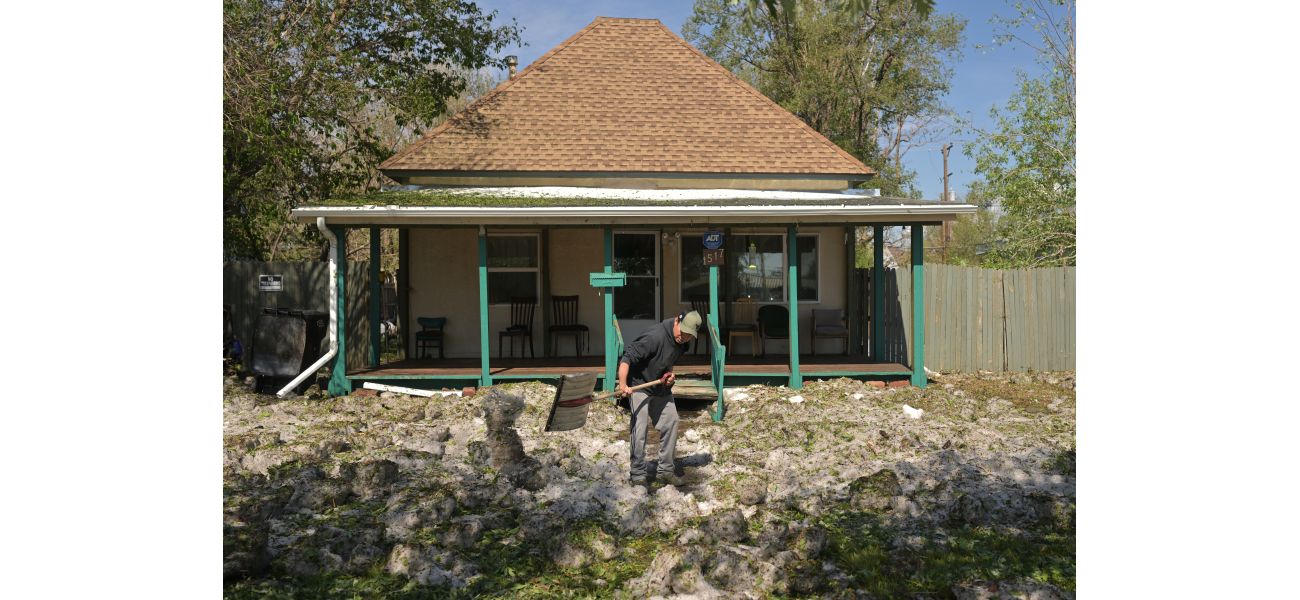Before selling a house in Colorado, roof replacement may be necessary.
Insurers' demands could hinder home sales.
November 10th 2024.

Home sales along the Front Range have become increasingly complicated due to changes in insurance policies. While insurance companies have not completely pulled out of the state like they have in California and Florida, they are making stricter demands that can cause issues for both buyers and sellers.
According to managing broker Matt Metcalf from Mile High Home Pro, insurance providers have decided not to insure roofs older than 10 years. This means that buyers are unable to obtain insurance for homes with older roofs, and even if they do, the premiums are so high that lenders are unable to finance the full amount needed for the mortgage.
In the past, the age of a roof was not a major issue until it reached 20 years. Additionally, if there was damage on a younger roof, insurers were willing to accept a repair instead of a full replacement. However, Metcalf has recently encountered two transactions where the roof unexpectedly needed to be replaced, causing difficult negotiations between the parties involved.
The inability to obtain insurance coverage has the potential to kill deals, as reported by agents. Cooper Thayer, a broker associate with the Thayer Group, advises starting the conversation about insurance early in the home buying process to ensure that the home is insurable. Most buyers are not willing to take on the cost of a roof replacement during a transaction, unless it is a highly desirable property.
Colorado has seen a rise in weather-related claims, including hail and wind damage, resulting in more home and auto insurance claims. In fact, Colorado ranks second in the country for hail risk and sixth for the premiums homeowners pay to insure their properties. Carole Walker, executive director of the Rocky Mountain Insurance Information Association, recommends that homeowners opt for impact-resistant shingles when replacing their roofs. Although they may be more expensive upfront, many insurers offer discounts for installing more durable shingles, which can save homeowners money in the long run.
Storms in Colorado have become so frequent that some insurers automatically assume a standard shingle roof has sustained damage. Metcalf advises being more aggressive when writing offers and asking about the age of the roof before making an offer.
Many buyers are not financially prepared to pay for a new roof, as they are already stretched thin with the costs associated with purchasing a home. Sellers may file a claim, but if the roof is in good condition, it is likely to be rejected. If a buyer cannot find insurance coverage unless the roof is replaced, it can create an impasse.
Even if an insurer allows for a replacement before the sale, if the policy is for actual cash value rather than replacement cash value, the owner will only receive the depreciated value of the roof. This means that the older the roof, the more the owner will have to pay out of pocket. Dustin Pitney, owner of Sky Manor Roofing & Exteriors, and a board member of the Denver Metro Association of Realtors, explains that many homeowners cannot afford to pay $8,000 to $10,000 for a new roof on top of their deductible, especially after paying insurance premiums for years.
As home prices have risen since 2013, most sellers should have enough equity to cover the cost of a new roof by deducting it from the sales price. However, this means that the seller's proceeds will be reduced. The average cost of a 2,000-square-foot roof in the U.S. is $14,000, but for larger or more complicated roofs, the cost can be two to three times higher.
If a buyer wants to upgrade to impact-resistant shingles, Metcalf suggests a compromise where the seller pays for a standard roof replacement and the buyer covers the cost of the upgraded shingles. This adds another level of negotiation to an already complex home sale process.
To avoid any issues with insurance and potential delays in the home buying process, Pitney advises sellers to get a roof inspection before listing their home. This can prevent any surprises that may arise during the transaction and potentially delay or even block the sale. In a market that is becoming increasingly favorable for buyers, it is important for sellers to be proactive and address any potential issues beforehand.
Insurers have not yet taken drastic measures to cut off coverage in the Front Range, unlike in California and Florida. However, they have been implementing stricter policies that can complicate and even hinder home sales. According to managing broker Matt Metcalf, insurance providers have recently decided to not insure roofs that are over 10 years old, which has caused some issues in the real estate and mortgage brokerage industry.
The issue does not affect current homeowners, but it poses a challenge for buyers looking to purchase a home with an older roof. Either the roof must be replaced before the sale, or the buyer must be willing to pay high premiums that may not be covered by their lender, making it difficult to secure financing. In the past, roofs over 20 years old were typically the only ones that caused concern, and insurers were willing to accept repairs for younger roofs. However, Metcalf has encountered two recent transactions where a roof replacement became necessary, leading to tough negotiations between the buyer and seller.
The negotiation process can become a battle of bargaining power, and in some cases, the lack of insurance coverage can even kill a deal. Broker associate Cooper Thayer advises starting the conversation about insurance early in the home buying process. He also adds that unless a home is highly desirable, most buyers are not willing to take on the cost of a roof replacement during a transaction. The frequency and severity of hailstorms and wind events in Colorado, the second-highest state for hail risk, have resulted in an increase in home and auto insurance claims. Coupled with rising claims from wildfires, Colorado now ranks sixth in the country for homeowners' insurance premiums.
Carole Walker, executive director of the Rocky Mountain Insurance Information Association, explains that roofing age is a risk factor that varies among insurance companies based on their individual guidelines. However, 10 years is considered a benchmark for asphalt roofs. Walker recommends installing impact-resistant shingles when replacing a roof, despite the higher upfront cost. Many insurers offer discounts for these more durable shingles, which can withstand hail better, reducing the need for claims and deductibles.
The damage caused by storms is often hidden beneath the shingles, making it difficult to detect without a professional inspection. Metcalf has become more aggressive when writing offers, always inquiring about the age of the roof before making an offer. He explains that many buyers are not in a financial position to cover the cost of a roof replacement, as they have already stretched their budget to cover down payments and other associated costs of purchasing a home.
Sellers may file a claim for a roof replacement, but it may be rejected if the roof is still in good condition. If a buyer cannot secure coverage unless the roof is replaced, it creates a stalemate in the negotiation process. Even if an insurer allows for a replacement before the sale, if the policy is for actual cash value rather than replacement cash value, the owner will only receive the depreciated value of the roof. This can result in the owner having to pay a significant amount out of pocket, which may not be feasible for many homeowners.
Dustin Pitney, owner of Sky Manor Roofing & Exteriors, and a board member of the Denver Metro Association of Realtors, explains that most homeowners cannot afford to pay for a new roof and their deductible, especially after paying insurance premiums for years. He recommends that sellers have their roof inspected before listing their home to avoid potential issues that could hinder a sale.
In the current market, most sellers should have enough equity to cover the cost of a roof replacement by deducting it from the sales price. However, this will result in the buyer having to oversee the replacement, which can be costly and time-consuming. The average cost of a 2,000-square-foot roof in the U.S. is $14,000, according to InchCalculator, and larger or more complex roofs can cost two to three times more.
If the buyer wants to install impact-resistant shingles, which is recommended by the insurance industry to prevent future issues, a compromise can be made. Metcalf suggests that the seller pays for a standard roof replacement, and the buyer covers the additional cost for the upgraded shingles. This adds another level of negotiation to the already complex process of buying a home. It is essential for buyers and sellers to be aware of the potential insurance issues and address them early on in the home buying process to avoid any complications or delays.
According to managing broker Matt Metcalf from Mile High Home Pro, insurance providers have decided not to insure roofs older than 10 years. This means that buyers are unable to obtain insurance for homes with older roofs, and even if they do, the premiums are so high that lenders are unable to finance the full amount needed for the mortgage.
In the past, the age of a roof was not a major issue until it reached 20 years. Additionally, if there was damage on a younger roof, insurers were willing to accept a repair instead of a full replacement. However, Metcalf has recently encountered two transactions where the roof unexpectedly needed to be replaced, causing difficult negotiations between the parties involved.
The inability to obtain insurance coverage has the potential to kill deals, as reported by agents. Cooper Thayer, a broker associate with the Thayer Group, advises starting the conversation about insurance early in the home buying process to ensure that the home is insurable. Most buyers are not willing to take on the cost of a roof replacement during a transaction, unless it is a highly desirable property.
Colorado has seen a rise in weather-related claims, including hail and wind damage, resulting in more home and auto insurance claims. In fact, Colorado ranks second in the country for hail risk and sixth for the premiums homeowners pay to insure their properties. Carole Walker, executive director of the Rocky Mountain Insurance Information Association, recommends that homeowners opt for impact-resistant shingles when replacing their roofs. Although they may be more expensive upfront, many insurers offer discounts for installing more durable shingles, which can save homeowners money in the long run.
Storms in Colorado have become so frequent that some insurers automatically assume a standard shingle roof has sustained damage. Metcalf advises being more aggressive when writing offers and asking about the age of the roof before making an offer.
Many buyers are not financially prepared to pay for a new roof, as they are already stretched thin with the costs associated with purchasing a home. Sellers may file a claim, but if the roof is in good condition, it is likely to be rejected. If a buyer cannot find insurance coverage unless the roof is replaced, it can create an impasse.
Even if an insurer allows for a replacement before the sale, if the policy is for actual cash value rather than replacement cash value, the owner will only receive the depreciated value of the roof. This means that the older the roof, the more the owner will have to pay out of pocket. Dustin Pitney, owner of Sky Manor Roofing & Exteriors, and a board member of the Denver Metro Association of Realtors, explains that many homeowners cannot afford to pay $8,000 to $10,000 for a new roof on top of their deductible, especially after paying insurance premiums for years.
As home prices have risen since 2013, most sellers should have enough equity to cover the cost of a new roof by deducting it from the sales price. However, this means that the seller's proceeds will be reduced. The average cost of a 2,000-square-foot roof in the U.S. is $14,000, but for larger or more complicated roofs, the cost can be two to three times higher.
If a buyer wants to upgrade to impact-resistant shingles, Metcalf suggests a compromise where the seller pays for a standard roof replacement and the buyer covers the cost of the upgraded shingles. This adds another level of negotiation to an already complex home sale process.
To avoid any issues with insurance and potential delays in the home buying process, Pitney advises sellers to get a roof inspection before listing their home. This can prevent any surprises that may arise during the transaction and potentially delay or even block the sale. In a market that is becoming increasingly favorable for buyers, it is important for sellers to be proactive and address any potential issues beforehand.
Insurers have not yet taken drastic measures to cut off coverage in the Front Range, unlike in California and Florida. However, they have been implementing stricter policies that can complicate and even hinder home sales. According to managing broker Matt Metcalf, insurance providers have recently decided to not insure roofs that are over 10 years old, which has caused some issues in the real estate and mortgage brokerage industry.
The issue does not affect current homeowners, but it poses a challenge for buyers looking to purchase a home with an older roof. Either the roof must be replaced before the sale, or the buyer must be willing to pay high premiums that may not be covered by their lender, making it difficult to secure financing. In the past, roofs over 20 years old were typically the only ones that caused concern, and insurers were willing to accept repairs for younger roofs. However, Metcalf has encountered two recent transactions where a roof replacement became necessary, leading to tough negotiations between the buyer and seller.
The negotiation process can become a battle of bargaining power, and in some cases, the lack of insurance coverage can even kill a deal. Broker associate Cooper Thayer advises starting the conversation about insurance early in the home buying process. He also adds that unless a home is highly desirable, most buyers are not willing to take on the cost of a roof replacement during a transaction. The frequency and severity of hailstorms and wind events in Colorado, the second-highest state for hail risk, have resulted in an increase in home and auto insurance claims. Coupled with rising claims from wildfires, Colorado now ranks sixth in the country for homeowners' insurance premiums.
Carole Walker, executive director of the Rocky Mountain Insurance Information Association, explains that roofing age is a risk factor that varies among insurance companies based on their individual guidelines. However, 10 years is considered a benchmark for asphalt roofs. Walker recommends installing impact-resistant shingles when replacing a roof, despite the higher upfront cost. Many insurers offer discounts for these more durable shingles, which can withstand hail better, reducing the need for claims and deductibles.
The damage caused by storms is often hidden beneath the shingles, making it difficult to detect without a professional inspection. Metcalf has become more aggressive when writing offers, always inquiring about the age of the roof before making an offer. He explains that many buyers are not in a financial position to cover the cost of a roof replacement, as they have already stretched their budget to cover down payments and other associated costs of purchasing a home.
Sellers may file a claim for a roof replacement, but it may be rejected if the roof is still in good condition. If a buyer cannot secure coverage unless the roof is replaced, it creates a stalemate in the negotiation process. Even if an insurer allows for a replacement before the sale, if the policy is for actual cash value rather than replacement cash value, the owner will only receive the depreciated value of the roof. This can result in the owner having to pay a significant amount out of pocket, which may not be feasible for many homeowners.
Dustin Pitney, owner of Sky Manor Roofing & Exteriors, and a board member of the Denver Metro Association of Realtors, explains that most homeowners cannot afford to pay for a new roof and their deductible, especially after paying insurance premiums for years. He recommends that sellers have their roof inspected before listing their home to avoid potential issues that could hinder a sale.
In the current market, most sellers should have enough equity to cover the cost of a roof replacement by deducting it from the sales price. However, this will result in the buyer having to oversee the replacement, which can be costly and time-consuming. The average cost of a 2,000-square-foot roof in the U.S. is $14,000, according to InchCalculator, and larger or more complex roofs can cost two to three times more.
If the buyer wants to install impact-resistant shingles, which is recommended by the insurance industry to prevent future issues, a compromise can be made. Metcalf suggests that the seller pays for a standard roof replacement, and the buyer covers the additional cost for the upgraded shingles. This adds another level of negotiation to the already complex process of buying a home. It is essential for buyers and sellers to be aware of the potential insurance issues and address them early on in the home buying process to avoid any complications or delays.
[This article has been trending online recently and has been generated with AI. Your feed is customized.]
[Generative AI is experimental.]
0
0
Submit Comment





